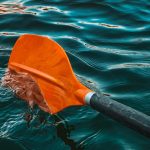In this guide we discuss different sizes of kayak paddles, give tips to help you select the right paddle length and consider other important paddle factors.

If you’ve never stepped on a paddle board before, chances are you’ve got no idea what to look for when shopping for the first time.
You’ll get hit with all this fancy jargon–planing hull vs. displacement hull, drop-stitching, thermoplastic vs. rotomolding, race boards and touring boards and whitewater boards–and it all sounds like so much gibberish to you.
Well, today, we’re taking you back to the very basics! We’re going to look at what size SUP you’re going to need based on the four most critical factors (plus one caveat).
By the time you get to the end of this article, you’ll know everything necessary to find the paddle boards best sized for you and anyone else you’re shopping for.
So let’s dive in and answer the question, “What size paddle board do I need?”
Why the Right Size Paddle Board Matters
Let me tell you a little story about a newbie paddler’s terrible first experiences on the water.
(In case you’re wondering, that newbie paddler is me.)
When I first tried paddle boarding, I borrowed a paddle board from a friend. A much smaller, lighter friend, I might clarify.
This friend, he’d fish off his paddle board for hours at a time, and he was so stable on his SUP that I was all but certain it would serve me well, too.
Boy, was I wrong!
The stand-up paddle board he used was sized just right for him. Me, though, I’m a good 50 pounds heavier and half a foot taller. When I tried to get on…well, let’s just say I spent more time in the lake that day than on it.
Really, I tried valiantly to get up, over and over, and managed to stay balanced on my knees well enough. But the board kept sinking into the water beneath my weight, and it was just too narrow to be properly steady.
Then I bought my own beginner paddle board, an inflatable board actually rated for my body weight and size.
And just like that, I was standing up and paddling around with ease.
See where I’m going with this (very embarrassing and true) story? A paddleboard that’s sized wrong is going to make your life a whole lot more challenging. But a correctly sized paddle board can make paddling easier even for newbies.
That’s the entire purpose of this article: to help you figure out the right size for your stand up paddle boards based on your height, weight, activity, and skill level.
Key Factors to Paddle Board Sizing

Finding the right size paddle board comes down to four factors:
- Length
- Width
- Thickness
- Volume and Weight Capacity (these work together)
Let me walk you through each factor to help you figure out what stand up paddle board dimensions are the most ideally suited to your specific physiology and desires.
Paddle Board Length
The majority of people who ask “What size paddle board do I need?” are really asking, “What length of stand up paddle board do I need?”
Length is the factor most commonly evaluated, because it’s the one that plays the largest role in how well your paddle boards handle, track, and balance.

Paddle boards come in three lengths:
8-10 Feet
SUP boards in the 8 to 10-foot range are typically designed for one of three purposes:
- Children. Because kids are shorter, a lot of beginner paddle boards for kids will be shorter, too. There’s less weight and height to worry about, and the shorter paddle boards are easier for kids to maneuver.
- Whitewater paddling. SUP boards built specifically for whitewater paddle boarding will be in this length range because the shorter boards are easier to maneuver into sharp turns or through tight spaces between obstacles.
- SUP surfing. SUP surfing requires a paddle board that can make sharp turns to catch and ride waves. Most SUPs designed for surf paddle boarding will be in the 8 to 10-foot range.
10-12 Feet
Most SUPs with a board length of 10 to 12 feet will be designed for one of three purposes:
- Recreational paddling. The extra length makes the boards more stable and strikes a good balance between maneuverability and tracking. This is the ideal beginner paddle board length.
- Paddle board fishing. SUP boards designed for fishing will also be in this length range, because they’re long enough to be stable and offer storage space for your fishing gear (tacklebox, cooler, seat, etc.) while still being maneuverable to paddle up narrow rivers and creeks to reach those secluded fishing holes.
- Paddleboard Yoga. Yoga SUP boards are much wider than the average paddle board (as you’ll see in the next section), but don’t necessarily need to be longer. Thus, the majority will be in this length range.
Note: Most inflatable paddle boards will be in the 10-12 foot length range. You may find a few in the longer or shorter ranges, but the vast majority of solo inflatable paddle boards will be under 12 (or 12.5) feet in length.
12+ Feet
Any paddle board over 12 feet long is considered “extra long”, and will usually be designed for one of three purposes:
- Tandem paddling. Though most paddleboards are built for one paddler, there are a few tandem SUP board models that you can use two at a time. The right option for a tandem paddle is going to be longer than the “standard paddle board” so both paddlers have space to sit and stretch out comfortably.
- Racing. Longer boards may be less maneuverable, but they can manage greater speeds and travel in a much straighter line. That’s why most racing boards (typically hard paddle boards, not inflatable paddle boards) are extra long.
- Touring. Touring boards designed to cover long distances across open waters are also built extra-long to ensure they move faster and track straighter. (Touring boards are also usually hard paddle boards.)
To Sum Up:
When it comes to the length of your SUP boards, the rule of thumb is simple:
- A longer board will move faster and track straighter
- A shorter paddle board will make sharper turns and be easier to maneuver
That should make it easy to remember what the ideal board’s length is for you.
Paddle Board Width

While most people trying to figure out the right board size will focus on length, board width is a critical factor to consider, too.
SUP board models come in three different width ranges:
Narrow Boards: 29 to 32″
Narrow boards are typically lighter than wider boards, and they can cover distance more quickly.
However, in sacrificing width, you also sacrifice stability.
Because of the way you stand (feet planted side by side), your balance is most likely to shift to the right or left (nor forward or backward). When you wobble, you’ll tip to the side–and if your balance is too far off, into the water you go.
No surprise, then, that narrow paddle boards are better suited to advanced paddlers.
Advanced paddlers will have experience not just wielding their paddle to cover long distances at top speed, but also maintaining their balance on a less-stable narrow board.
Plus, narrow boards will typically have higher secondary stability (courtesy of their displacement hull design) and will be better suited to handling currents, waves, and swells.
Most touring, racing, whitewater, or surfing SUPs fall into this board width range.
Average Boards: 31 to 33″
Your “average paddle board size” will usually be in the 31 to 33-inch width range. At this width, the board is wide enough to be suitable for newbies who are just getting their balance, but advanced paddlers will still be able to handle them effectively.
The best paddle board models for beginners, recreational paddling, and SUP fishing fall into this category. The majority of inflatable boards will be in this width range, too.
Wide Boards: 34 to 36″
There is really only one reason to use a very wide board: you want a lot of stability.
In stark contrast to a narrower board, a wider board has much greater primary stability, so it’ll stay balanced and stable on flat water. Sure, you’ll be more prone to tipping over if you’re on choppy water (which is why most long-distance paddle boarding is done on a narrower board with higher secondary stability), but as long as you’re on a calm river or lake, you’ll feel like you’re floating on a raft.
SUP Yoga boards are usually in this width range. Many beginner paddle boards will fall into this width range, too, as the extra width provides added stability for newbies who haven’t yet mastered the balance.

To Sum Up:
When it comes to the width of your SUP boards, the rule of thumb is simple:
- A wider board will provide excellent primary stability but will move more slowly
- A narrower board will have better secondary stability and travel more swiftly
Easy to see which size SUP board (by width) suits you best, right?
Paddle Board Thickness
The thickness of your paddle board matters in the same way length and width do: it’s a factor in both performance and stability.
Most paddle boards come in two thickness ranges:
2 to 4 inches
Most solid board models (with a hard shell formed from wood, plastic, fiberglass, or carbon fiber) will be in this thickness range.
Thinner boards are less stable but will be far more responsive on the water. You’ll feel every ripple, current, and wave, which makes them perfect for SUP surfing, whitewater paddling, touring, and racing.
4 to 6 inches
Most inflatable paddle boards fall into this thickness range, for one very good reason: inflatable paddle boards are created to be more buoyant and stable. A thicker paddle board can be filled with more air, which increases both buoyancy and stability.
Beginners to paddle boarding will love the added thickness of an inflatable SUP, because it creates a solid platform that is far less likely to tip over.
The added buoyancy and stability of the inflatable paddle board types make them the best paddle board for SUP Yoga, fishing, and a great all-around paddle board for newbies who are just getting their bearings and want to enjoy paddle boarding without stumbling and fumbling.
Really, a thicker board is better for any weight and skill level, which is one likely reason inflatable SUPs have become so much more popular than solid boards in the last few years.

Thickness = Sturdiness
One important thing to note is that your SUP thickness will have a direct correlation to its durability.
When you stand on a paddle board, all of your body weight is resting directly in the center–a.k.a. the weakest point. A board that’s too thin (and built shoddily) will start to bend, bow, and eventually “banana” beneath your weight.
That’s why many inflatable boards are thicker. The extra thickness means more air to not only increase the board’s buoyancy, but also to provide resistance against your body weight and reduce the risk the board will bow or sag.
A Note on “Uniform Thickness”
Most inflatable SUPs will have “uniform thickness”, meaning the entire board is the same thickness. This is due to their planing hulls, which are built flat in order to ride atop the water.
By contrast, while some hard board models have a planing hull, many will feature displacement hulls that are rounded and curved with a pointed nose. These hulls are designed specifically to slice through the water at high speeds, paddle long distances, and maintain their stability even when the water is choppy.
SUP thickness on these long-distance paddling models will range–they may be 2 inches at their thinnest point, and 4 inches at their thickest.
To Sum Up:
When it comes to board thickness, the rule of thumb is simple:
- A thinner board will be more responsive on the water but less stable
- A thicker board will be more stable and have a higher weight capacity, but will be less maneuverable
Paddle Board Volume and Weight Capacity
The last factors to calculate when evaluating paddle board size are volume and weight capacity.
These two factors essentially go hand in hand, and understanding why they matter will help you choose the right hard board or inflatable SUP.
Volume
Volume is a metric calculated in liters that tells you just how buoyant the board is. It’s a metric that’s more important for advanced paddle boarders, but even beginner paddlers should know the basics of how to calculate the board’s volume.

Volume matters in regards to two factors:
- The paddler’s weight.
- The paddling conditions/the paddler’s skill level.
Let me explain…
For a beginner paddle boarder, a board with a higher volume is desirable because there is more board to provide stability as well as buoyancy.
The more advanced you are, the more adept you become at maintaining your balance even when the water is choppy. You also become skilled at using the instability of the board to your favor–for example, when riding waves or whitewater rapids.
Here are our recommendations for calculating the “ideal” volume for you:
- For total newbies or people who struggle to maintain their balance, the formula is: body weight (in kg) x 2.2 to 3. That will tell you the approximate volume in liters.
- For racing boards, the formula is the same: body weight (in kg) x 2.2 to 3.
- For novices who are getting the hang of their balance, they can use a board with a lower volume. The formula is: body weight (in kg) x 1.8 to 2.2.
- For intermediate paddlers who are paddling in rough conditions (choppy water), the formula is the same: body weight (in kg) x 1.8 to 2.2.
- For advanced paddleboarders and skilled SUP surfers, the formula is: body weight (in kg) x 1.3 to 1.8.
- For expert-level paddleboarders and SUP surfers, the formula is: body weight (in kg) x 1.1 to 1.3.
Weight Capacity
Weight capacity is a number most paddle board manufacturers will present (instead of volume) in order to make it easy for you to see just how suitable a SUP size is for your specific body type and weight.
The “weight capacity” metric has done all the math and just tells you how much weight a board can handle (usually below 70% of its volume by cubic liters).
For people with a larger body type (like myself), this makes it easy to see if the SUP size is up to carrying your weight. If not, you can always look for greater SUP width, length, or thickness with a higher weight capacity.
Remember:
- Inflatable SUPs typically have a higher weight capacity because of their larger design and added buoyancy
- Hard-shell SUPs (like those used for SUP touring, racing, or surfing) will usually have a lower capacity.
- Wider and longer SUPs will have a higher weight capacity, while narrower SUPs (like those for SUP touring or racing) and shorter SUPs (like surfing and whitewater SUPs) will have a lower capacity.
Important Caveat: Type Matters, Too
As I mentioned above, there are four crucial factors that go into deciding the right size of paddleboard, but this factor–paddleboard type–also needs to be taken into consideration.
Think about it:
- A surf SUP and whitewater SUP are nearly the same design, but one is much sturdier and better-suited to surviving collisions, while the other is built specifically to ride waves.
- A racing SUP and touring SUP are fairly similar in design, but one is constructed to handle the tough currents and the open ocean, while the other is built to paddle much faster.
- A fishing and Yoga SUP will be fairly similar in design, but one will be longer and more stable, the other thinner and more maneuverable.
SUP width, length, thickness, volume, and weight capacity are important, but they’re just the beginning. You’ve also got to factor in the type of paddleboard so you get a board built specifically for the activity you’re planning.
Paddle Board Sizing FAQs
Paddler height isn’t a very important factor to consider, because most paddle boards are 10+ feet in length, and even very tall people (like me) won’t be above 6+ feet.
An inflatable SUP will be ideal for heavier beginner boarders. The high primary stability and buoyancy of the thicker, longer, wider board will make for a much steadier “platform” to stand on.
Kids are agile and athletic, so they can use pretty much any type of paddleboard, of any length, width, or thickness. However, you may want to consider a sturdy inflatable or even a tough hardshell that can withstand sort of bumps, knocks, scrapes, and roughhousing you can expect from kids enjoying water sports.
A longer, wider, thicker inflatable board will be great for paddling with pets who like to get in and out of the water. Not only can you bring them along with you, but you can carry extra gear (like pet treats, water, pet lifejackets, etc.) as well.
But be warned: if your pet has sharp nails/claws, they may puncture a cheaper inflatable paddle board built with lower-quality, less durable materials. Either spend on a tougher, sturdier inflatable or go the hard-shell route.









